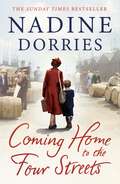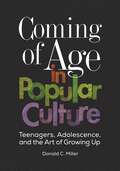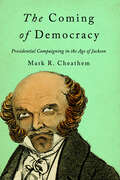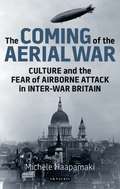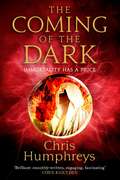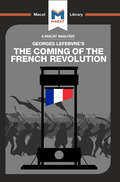- Table View
- List View
Coming Home: How Midwives Changed Birth
by Wendy KlineBy the mid-twentieth century, two things appeared destined for extinction in the United States: the practice of home birth and the profession of midwifery. In 1940, close to half of all U.S. births took place in the hospital, and the trend was increasing. By 1970, the percentage of hospital births reached an all-time high of 99.4%, and the obstetrician, rather than the midwife, assumed nearly complete control over what had become an entirely medicalized procedure. Then, seemingly out of nowhere, an explosion of new alternative organizations, publications, and conferences cropped up, documenting a very different demographic trend; by 1977, the percentage of out-of-hospital births had more than doubled. Home birth was making a comeback, but why? The executive director of the American College of Obstetricians and Gynecologists publicly noted in 1977 the "rising tide of demand for home delivery," describing it as an "anti-intellectual-anti-science revolt." A quiet revolution spread across cities and suburbs, towns and farms, as individuals challenged legal, institutional and medical protocols by choosing unlicensed midwives to catch their babies at home. Coming Home analyzes the ideas, values, and experiences that led to this quiet revolution and its long-term consequences for our understanding of birth, medicine, and culture. Who were these self-proclaimed midwives and how did they learn their trade? Because the United States had virtually eliminated midwifery in most areas by the mid-twentieth century, most of them had little knowledge of or exposure to the historic practice, drawing primarily on obstetrical texts, trial and error, and sometimes instruction from aging home birth physicians to learn their craft. While their constituents were primarily drawn from the educated white middle class, their model of care (which ultimately drew on the wisdom and practice of a more diverse, global pool of midwives) had the potential to transform birth practices for all women, both in and out of the hospital.
Coming Home: Conatains: 3 Each Of:shell Seekers; Coming Home; Carousel; Wild Mountain (Basic Ser.)
by Rosamunde PilcherA heartwarming novel by the much-loved Rosamunde Pilcher.Born in Colombo, Judith Dunbar spends her teenage years at boarding school, while her beloved mother and younger sister live abroad with her father.When her new friend Loveday Carey-Lewis invites Judith home for the weekend to Nancherrow, the Carey-Lewises' beautiful estate on the Cornish coast, it is love at first sight.She falls in love too with the generous Carey-Lewises themselves. With their generosity and kindness, Judith grows from naive girl to confident young woman, basking in the warm affection of a surrogate family whose flame burns brightly. But it is a flame soon to be extinguished in the gathering storm of war. And Judith herself has far to travel before at last . . . coming home.
Coming Home to a Foreign Country: Xiamen and Returned Overseas Chinese, 1843–1938
by Soon Keong OngOng Soon Keong explores the unique position of the treaty port Xiamen (Amoy) within the China-Southeast Asia migrant circuit and examines its role in the creation of Chinese diasporas. Coming Home to a Foreign Country addresses how migration affected those who moved out of China and later returned to participate in the city's economic revitalization, educational advancement, and urban reconstruction. Ong shows how the mobility of overseas Chinese allowed them to shape their personal and community identities for pragmatic and political gains. This resulted in migrants who returned with new money, knowledge, and visions acquired abroad, which changed the landscape of their homeland and the lives of those who stayed. Placing late Qing and Republican China in a transnational context, Coming Home to a Foreign Country explores the multilayered social and cultural interactions between China and Southeast Asia. Ong investigates the role of Xiamen in the creation of a China-Southeast Asia migrant circuit; the activities of aspiring and returned migrants in Xiamen; the accumulation and manipulation of multiple identities by Southeast Asian Chinese as political conditions changed; and the motivations behind the return of Southeast Asian Chinese and their continual involvement in mainland Chinese affairs. For Chinese migrants, Ong argues, the idea of "home" was something consciously constructed. Ong complicates familiar narratives of Chinese history to show how the emigration and return of overseas Chinese helped transform Xiamen from a marginal trading outpost at the edge of the Chinese empire to a modern, prosperous city and one of the most important migration hubs by the 1930s.
Coming Home to Germany?: The Integration of Ethnic Germans from Central and Eastern Europe in the Federal Republic since 1945 (Culture & Society in Germany #4)
by David Rock Stefan WolffThe end of World War II led to one of the most significant forced population transfers in history: the expulsion of over 12 million ethnic Germans from Central and Eastern Europe between 1945 and 1950 and the subsequent emigration of another four million in the second half of the twentieth century. Although unprecedented in its magnitude, conventional wisdom has it that the integration of refugees, expellees, and Aussiedler was a largely successful process in postwar Germany. While the achievements of the integration process are acknowledged, the volume also examines the difficulties encountered by ethnic Germans in the Federal Republic and analyses the shortcomings of dealing with this particular phenomenon of mass migration and its consequences.
Coming Home to Liverpool
by Kate EasthamA stirring and inspiring story perfect for fans of Nadine Dorries and Call The MidwifeHeartbroken but determined, Maud Linklater returns to her hometown of Liverpool intent on healing the sick and building a new life for herself and her son, AlfieLiverpool 1872After spending time training at the Infirmary for Women in New York, Maud can't wait to put her new-found skills to the test. But in a city built and run by men she must work hard to be accepted.Whilst her nurse friends welcome her back with open arms there are others who do not wish her well, including the spiteful Nancy Sellers.Nancy resented Maud's talents as a nurse and seeing her arrive back with such fanfare puts her nose firmly out of joint. She will stop at nothing to sabotage Maud's life and soon turns her attention to those Maud holds most dear.Maud Linklater is made of strong stuff. But as she resettles back into life in her hometown, can she overcome any obstacle Nancy, and Liverpool, might throw her way?Praise for Kate Eastham'Deftly written and moving' Woman's Own'A heart-warming and tear-inducing tale with wonderfully realistic characters' WomanDiscover other books in The Nursing Series: Miss Nightingale's Nurses, The Liverpool Nightingale's and Daughters of Liverpool.
Coming Home to the Four Streets (The Four Streets #4)
by Nadine Dorries'A moving and engaging addition to the family saga and drama of The Four Streets... Vibrancy and colour warm the pages' LoveReading In equal measure gritty and tender, Coming Home to the Four Streets is the latest instalment in the Four Streets saga, from Sunday Times bestseller Nadine Dorries.Trouble is coming to the four streets, especially for its redoubtable women, who've struggled through a bitter winter to put food on the table. The Dock Queen Carnival is only weeks away, but there's no money for the usual celebrations. No sign of a tramp ship with illicit cargo to be quietly siphoned off by the dockers.Peggy Nolan, with seven boys and a husband too lazy to work, has hit rock bottom and is hiding a terrible secret. Little Paddy, her mischievous eldest, is all too often in trouble, but he'd do anything for the mother he loves. How can he save her from selling herself on the streets – or worse?Maura and Tommy Doherty always looked out for any neighbour in trouble, especially Peggy, but they're far away, running a pub in Ireland and corrupt copper, Frank the Skank, is moving into their old house on the four streets. Can anything bring them home in time?Praise for Nadine Dorries:'A moving and engaging addition to the family saga and drama of The Four Streets... Just as warm, gossipy and familiar as I remember... Vibrancy and colour warm the pages... Coming Home to the Four Streets will appeal to anyone who loves an entertaining family saga, this is a satisfying and rewarding return to the series' LoveReading'Charming, gutsy and full of raw emotions' Rachel Bustin'The characters are engaging, the streets scenes cinematic and the theme of the novel – abuse, both sexual and domestic – powerful' The Times'Angela's Ashes with a scouse accent' Irish Times
Coming of Age: Constructing and Controlling Youth in Munich, 1942-1973
by Martin KalbIn the lean and anxious years following World War II, Munich society became obsessed with the moral condition of its youth. Initially born of the economic and social disruption of the war years, a preoccupation with juvenile delinquency progressed into a full-blown panic over the hypothetical threat that young men and women posed to postwar stability. As Martin Kalb shows in this fascinating study, constructs like the rowdy young boy and the sexually deviant girl served as proxies for the diffuse fears of adult society, while allowing authorities ranging from local institutions to the U.S. military government to strengthen forms of social control.
Coming of Age in Medieval Egypt: Female Adolescence, Jewish Law, and Ordinary Culture
by Eve KrakowskiMuch of what we know about life in the medieval Islamic Middle East comes from texts written to impart religious ideals or to chronicle the movements of great men. How did women participate in the societies these texts describe? What about non-Muslims, whose own religious traditions descended partly from pre-Islamic late antiquity?Coming of Age in Medieval Egypt approaches these questions through Jewish women’s adolescence in Fatimid and Ayyubid Egypt and Syria (c. 969–1250). Using hundreds of everyday papers preserved in the Cairo Geniza, Eve Krakowski follows the lives of girls from different social classes—rich and poor, secluded and physically mobile—as they prepared to marry and become social adults. She argues that the families on whom these girls depended were more varied, fragmented, and fluid than has been thought. Krakowski also suggests a new approach to religious identity in premodern Islamic societies—and to the history of rabbinic Judaism. Through the lens of women’s coming-of-age, she demonstrates that even Jews who faithfully observed rabbinic law did not always understand the world in rabbinic terms. By tracing the fault lines between rabbinic legal practice and its practitioners’ lives, Krakowski explains how rabbinic Judaism adapted to the Islamic Middle Ages.Coming of Age in Medieval Egypt offers a new way to understand how women took part in premodern Middle Eastern societies, and how families and religious law worked in the medieval Islamic world.
Coming of Age in Medieval Egypt: Female Adolescence, Jewish Law, and Ordinary Culture
by Eve KrakowskiMuch of what we know about life in the medieval Islamic Middle East comes from texts written to impart religious ideals or to chronicle the movements of great men. How did women participate in the societies these texts describe? What about non-Muslims, whose own religious traditions descended partly from pre-Islamic late antiquity?Coming of Age in Medieval Egypt approaches these questions through Jewish women’s adolescence in Fatimid and Ayyubid Egypt and Syria (c. 969–1250). Using hundreds of everyday papers preserved in the Cairo Geniza, Eve Krakowski follows the lives of girls from different social classes—rich and poor, secluded and physically mobile—as they prepared to marry and become social adults. She argues that the families on whom these girls depended were more varied, fragmented, and fluid than has been thought. Krakowski also suggests a new approach to religious identity in premodern Islamic societies—and to the history of rabbinic Judaism. Through the lens of women’s coming-of-age, she demonstrates that even Jews who faithfully observed rabbinic law did not always understand the world in rabbinic terms. By tracing the fault lines between rabbinic legal practice and its practitioners’ lives, Krakowski explains how rabbinic Judaism adapted to the Islamic Middle Ages.Coming of Age in Medieval Egypt offers a new way to understand how women took part in premodern Middle Eastern societies, and how families and religious law worked in the medieval Islamic world.
Coming of Age in Medieval Egypt: Female Adolescence, Jewish Law, and Ordinary Culture
by Eve KrakowskiMuch of what we know about life in the medieval Islamic Middle East comes from texts written to impart religious ideals or to chronicle the movements of great men. How did women participate in the societies these texts describe? What about non-Muslims, whose own religious traditions descended partly from pre-Islamic late antiquity?Coming of Age in Medieval Egypt approaches these questions through Jewish women’s adolescence in Fatimid and Ayyubid Egypt and Syria (c. 969–1250). Using hundreds of everyday papers preserved in the Cairo Geniza, Eve Krakowski follows the lives of girls from different social classes—rich and poor, secluded and physically mobile—as they prepared to marry and become social adults. She argues that the families on whom these girls depended were more varied, fragmented, and fluid than has been thought. Krakowski also suggests a new approach to religious identity in premodern Islamic societies—and to the history of rabbinic Judaism. Through the lens of women’s coming-of-age, she demonstrates that even Jews who faithfully observed rabbinic law did not always understand the world in rabbinic terms. By tracing the fault lines between rabbinic legal practice and its practitioners’ lives, Krakowski explains how rabbinic Judaism adapted to the Islamic Middle Ages.Coming of Age in Medieval Egypt offers a new way to understand how women took part in premodern Middle Eastern societies, and how families and religious law worked in the medieval Islamic world.
Coming of Age in Popular Culture: Teenagers, Adolescence, and the Art of Growing Up
by Donald C. MillerDocumenting the evolution of teens and media from the 1950s through 2010, this book examines the films, books, television shows, and musical artists that impacted American culture and shaped the "coming of age" experience for each generation.The teenage years are fraught with drama and emotional ups and downs, coinciding with bewildering new social situations and sexual tension. For these reasons, pop culture and media have repeatedly created entertainment that depicts, celebrates, or lampoons coming of age experiences, through sitcoms like The Wonder Years to the brat pack films of the 1980s to the teen-centered television series of today. Coming of Age in Popular Culture: Teenagers, Adolescence, and the Art of Growing Up covers a breadth of media presentations of the transition from childhood to adulthood from the 1950s to the year 2010. It explores the ways that adolescence is characterized in pop culture by drawing on these representations, shows how powerful media and entertainment are in establishing societal norms, and considers how American society views and values adolescence. Topics addressed include race relations, gender roles, religion, and sexual identity. Young adult readers will come away with a heightened sense of media literacy through the examination of a topic that inherently interests them.
Coming of Age in Popular Culture: Teenagers, Adolescence, and the Art of Growing Up
by Donald C. MillerDocumenting the evolution of teens and media from the 1950s through 2010, this book examines the films, books, television shows, and musical artists that impacted American culture and shaped the "coming of age" experience for each generation.The teenage years are fraught with drama and emotional ups and downs, coinciding with bewildering new social situations and sexual tension. For these reasons, pop culture and media have repeatedly created entertainment that depicts, celebrates, or lampoons coming of age experiences, through sitcoms like The Wonder Years to the brat pack films of the 1980s to the teen-centered television series of today. Coming of Age in Popular Culture: Teenagers, Adolescence, and the Art of Growing Up covers a breadth of media presentations of the transition from childhood to adulthood from the 1950s to the year 2010. It explores the ways that adolescence is characterized in pop culture by drawing on these representations, shows how powerful media and entertainment are in establishing societal norms, and considers how American society views and values adolescence. Topics addressed include race relations, gender roles, religion, and sexual identity. Young adult readers will come away with a heightened sense of media literacy through the examination of a topic that inherently interests them.
The Coming of Democracy: Presidential Campaigning in the Age of Jackson
by Mark R. CheathemAfter the "corrupt bargain" that awarded John Quincy Adams the presidency in 1825, American politics underwent a fundamental shift from deference to participation. This changing tide eventually propelled Andrew Jackson into the White House;¢;‚¬;€?twice. But the presidential race that best demonstrated the extent of the changes was that of Martin Van Buren and war hero William Henry Harrison in 1840. Harrison;€™s campaign was famously marked by sloganeering and spirited rallies. In The Coming of Democracy, Mark R. Cheathem examines the evolution of presidential campaigning from 1824 to 1840. Addressing the roots of early republic cultural politics;¢;‚¬;€?from campaign biographies to songs, political cartoons, and public correspondence between candidates and voters;¢;‚¬;€?Cheathem asks the reader to consider why such informal political expressions increased so dramatically during the Jacksonian period. What sounded and looked like mere entertainment, he argues, held important political meaning. The extraordinary voter participation rate;¢;‚¬;€?over 80 percent;¢;‚¬;€?in the 1840 presidential election indicated that both substantive issues and cultural politics drew Americans into the presidential selection process.Drawing on period newspapers, diaries, memoirs, and public and private correspondence, The Coming of Democracy is the first book-length treatment to reveal how presidents and presidential candidates used both old and new forms of cultural politics to woo voters and win elections in the Jacksonian era. This book will appeal to anyone interested in US politics, the Jacksonian/antebellum era, or the presidency.
The Coming of Democracy: Presidential Campaigning in the Age of Jackson
by Mark R. CheathemAfter the "corrupt bargain" that awarded John Quincy Adams the presidency in 1825, American politics underwent a fundamental shift from deference to participation. This changing tide eventually propelled Andrew Jackson into the White House;¢;‚¬;€?twice. But the presidential race that best demonstrated the extent of the changes was that of Martin Van Buren and war hero William Henry Harrison in 1840. Harrison;€™s campaign was famously marked by sloganeering and spirited rallies. In The Coming of Democracy, Mark R. Cheathem examines the evolution of presidential campaigning from 1824 to 1840. Addressing the roots of early republic cultural politics;¢;‚¬;€?from campaign biographies to songs, political cartoons, and public correspondence between candidates and voters;¢;‚¬;€?Cheathem asks the reader to consider why such informal political expressions increased so dramatically during the Jacksonian period. What sounded and looked like mere entertainment, he argues, held important political meaning. The extraordinary voter participation rate;¢;‚¬;€?over 80 percent;¢;‚¬;€?in the 1840 presidential election indicated that both substantive issues and cultural politics drew Americans into the presidential selection process.Drawing on period newspapers, diaries, memoirs, and public and private correspondence, The Coming of Democracy is the first book-length treatment to reveal how presidents and presidential candidates used both old and new forms of cultural politics to woo voters and win elections in the Jacksonian era. This book will appeal to anyone interested in US politics, the Jacksonian/antebellum era, or the presidency.
The Coming of Globalization: Its Evolution and Contemporary Consequences
by R. LanghorneThe Coming of Globalization provides the basic context for understanding what globalization means for human society in the contemporary world. It first describes the underlying processes which have led to economic, political and cultural globalization and then sets out the present stage in the evolution of these processes in three vital areas: global capitalism and global markets; the changing relationship between national governments and their peoples; and the conduct of global international relationships. The author concludes by discussing some likely outcomes, both good and bad.
The Coming of Sound
by Douglas GomeryThe coming of sound to film was an event whose importance can hardly be overestimated; sound transformed not only the Hollywood film industry but all of world cinema as well. As economic and film historian Douglas Gomery explains, the business of film became not only bigger but much more complex. As sound spread its power, the talkies became an agent of economic and social change through the globe, extending America's reach in ways that had never before been imaginable.This is an essential work for anyone interested in early film, film history and economics, and the history of the American media.
The Coming of Sound
by Douglas GomeryThe coming of sound to film was an event whose importance can hardly be overestimated; sound transformed not only the Hollywood film industry but all of world cinema as well. As economic and film historian Douglas Gomery explains, the business of film became not only bigger but much more complex. As sound spread its power, the talkies became an agent of economic and social change through the globe, extending America's reach in ways that had never before been imaginable.This is an essential work for anyone interested in early film, film history and economics, and the history of the American media.
The Coming of the Aerial War: Culture and the Fear of Airborne Attack in Inter-War Britain (International Library of Twentieth Century History)
by Michele HaapamäkiIn the first half of the 20th century the possibility of flight opened up entirely new avenues of thought and exploration. In the age of H.G. Wells and Biggles, the opening up of the air to balloons and planes - the Royal Flying Corps was founded in 1912 - appealed to concepts of courage and bravery which would be both encouraged and undermined by the experiences of World War I. The sky also held new terrors for everyday people who were now within reach of an airborne enemy - these fears included the possibilities of bombing, poison gas, surveillance and social control. This duality of fear and enthusiasm drove the Air Raid Precaution movement, while vocal elements in the press and in parliament called for radical plans to cope with apocalyptic scenarios. Here, Michele Haapamäki charts the history of flight and of war in the air in the early 20th century, addressing the key issues of interwar historiography such as patriotism, fear, masculinity and propaganda.
The Coming of the Dark (Immortal's Blood)
by Chris HumphreysThree lands. Each ruled in different ways by a decadent immortal elite for their own pleasure and power. They know nothing of each other. But there is a fourth, vast land of mortals. Led by black-eyed priests, the tribes have put aside centuries of hate to unite under the prophecy of 'the One': a child saviour who is neither boy nor girl. Now they are finally ready to conquer the whole world... and wipe the immortals out.Yet in each of those other worlds there are some who will resist, even unto a final death.Luck, a malformed god of the Northmen, desperate to give up a drug that shows him the whole world clearly, even as it destroys his will to fight for it. Ferros, a brilliant warrior recently made immortal, torn between new and old loyalties and loves. Atisha, mother of 'the One', determined to defeat all plans that have been made for her child.Among battles on sea and land, the fall of empires and the rise of the Mortals, will come the Triumph of the One.But will it be a final darkness? Or is there someone who can still save the light?
The Coming of the French Revolution (Princeton Classics #72)
by Georges LefebvreThe Coming of the French Revolution remains essential reading for anyone interested in the origins of this great turning point in the formation of the modern world. First published in 1939, on the eve of the Second World War, and suppressed by the Vichy government, this classic work explains what happened in France in 1789, the first year of the French Revolution. Georges Lefebvre wrote history "from below"—a Marxist approach. Here, he places the peasantry at the center of his analysis, emphasizing the class struggles in France and the significant role they played in the coming of the revolution.Eloquently translated by the historian R. R. Palmer and featuring an introduction by Timothy Tackett that provides a concise intellectual biography of Lefebvre and a critical appraisal of the book, this Princeton Classics edition continues to offer fresh insights into democracy, dictatorship, and insurrection.
The Coming of the French Revolution
by Georges Lefebvre R. R. Palmer Timothy TackettThe Coming of the French Revolution remains essential reading for anyone interested in the origins of this great turning point in the formation of the modern world. First published in 1939, on the eve of the Second World War, and suppressed by the Vichy government, this classic work explains what happened in France in 1789, the first year of the French Revolution. Georges Lefebvre wrote history "from below"—a Marxist approach. Here, he places the peasantry at the center of his analysis, emphasizing the class struggles in France and the significant role they played in the coming of the revolution.Eloquently translated by the historian R. R. Palmer and featuring an introduction by Timothy Tackett that provides a concise intellectual biography of Lefebvre and a critical appraisal of the book, this Princeton Classics edition continues to offer fresh insights into democracy, dictatorship, and insurrection.
The Coming of the French Revolution (The Macat Library)
by Tom StammersGeorges Lefebvre was one of the most highly-regarded historians of the 20th century – and a key reason for the high reputation he enjoys can be found in The Coming of the French Revolution. Lefebvre's key contribution to the debate over what remains arguably one of history's most contentious and significant events in history was to deploy the critical thinking skill of evaluation to reveal weaknesses in existing arguments about the causes of the Revolution, and analytical skills to expose hidden assumptions in them. Rather than seeing events as driven by the aristocracy and the bourgeoisie – which then lost power to the urban workers – as was usual at the time, Lefebvre deployed years of research in regional archives to argue that the Revolution had had a fourth pillar: the peasantry. Painting the upheaval as complex and multi-layered – while still privileging a predominantly economic interpretation – Lefebvre provides a compelling new narrative to explain why the French monarchy collapsed so suddenly in 1789: one that stressed the significance of a ‘popular revolution’ in the rural countryside.
The Coming of the French Revolution (The Macat Library)
by Tom StammersGeorges Lefebvre was one of the most highly-regarded historians of the 20th century – and a key reason for the high reputation he enjoys can be found in The Coming of the French Revolution. Lefebvre's key contribution to the debate over what remains arguably one of history's most contentious and significant events in history was to deploy the critical thinking skill of evaluation to reveal weaknesses in existing arguments about the causes of the Revolution, and analytical skills to expose hidden assumptions in them. Rather than seeing events as driven by the aristocracy and the bourgeoisie – which then lost power to the urban workers – as was usual at the time, Lefebvre deployed years of research in regional archives to argue that the Revolution had had a fourth pillar: the peasantry. Painting the upheaval as complex and multi-layered – while still privileging a predominantly economic interpretation – Lefebvre provides a compelling new narrative to explain why the French monarchy collapsed so suddenly in 1789: one that stressed the significance of a ‘popular revolution’ in the rural countryside.
The Coming of the Friars
by Rosalind B. BrookeOriginally published in 1975, this book helps students understand why the Movements of the 12th century remained much more enclosed and monastic or turned to heresy; How much the new orders of Friars owed to the earlier movements and to what extent they arose from the personal inspiration of Saint Francis and Saint Dominic. The introduction is arranged to help the documents to speak for themselves: it opens with a direct confrontation with Francis then goes back to search the religious experience of the 10th to 12th centuries for movements and especially well documented individuals who can help explain the development of fashions and ideas. There are sections on precursors, both monks and heretics, and on the papal policies towards these movements, and the introduction closes with a chapter on Dominic and an epilogue on the impact of the Friars.
The Coming of the Friars
by Rosalind B. BrookeOriginally published in 1975, this book helps students understand why the Movements of the 12th century remained much more enclosed and monastic or turned to heresy; How much the new orders of Friars owed to the earlier movements and to what extent they arose from the personal inspiration of Saint Francis and Saint Dominic. The introduction is arranged to help the documents to speak for themselves: it opens with a direct confrontation with Francis then goes back to search the religious experience of the 10th to 12th centuries for movements and especially well documented individuals who can help explain the development of fashions and ideas. There are sections on precursors, both monks and heretics, and on the papal policies towards these movements, and the introduction closes with a chapter on Dominic and an epilogue on the impact of the Friars.





